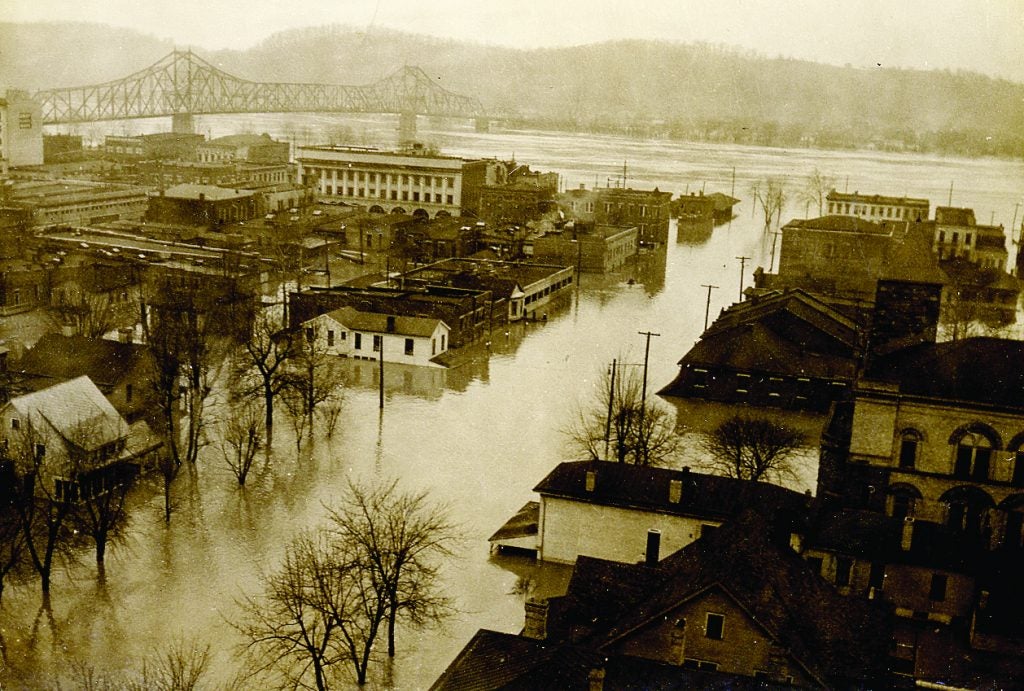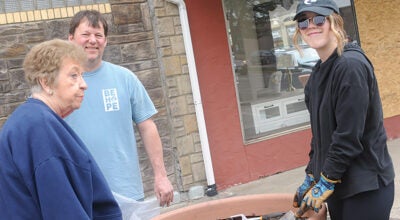Remembering the 1937 flood
Published 1:32 am Sunday, January 29, 2017

- View of the flood waters looking into downtown Ironton.
After eight decades, memories remain
It was eight decades ago when the mighty Ohio River swept over its banks and left many towns under several feet of water. The effects of the flooding were felt from Cairo, Illinois, to Pittsburg, Pennsylvania, and even parts along the Mississippi River.
It was nearly devastating locally. Heavy rains started on Jan. 19, 1937.
By Jan. 27, there was 20 feet of water in downtown Ironton and the entire town of Proctorville was flooded.
Ninety percent of Ironton was under water with its citizens cut off from both roads and railways with an estimated 8,000 of the town’s 20,000 residents.
The water was so high that when Ohio Gov. Martin L. Davey toured Ironton by boat, he had to watch so his head didn’t hit traffic lights.
Jean Fuller Butler was nine years old and living on a farm two miles above Proctorville fairgrounds when the town was flooded.
“Pop said it was because it snowed so much that winter,” she said. “It was a hard winter.”
Being on higher ground meant the family farm wasn’t flooded.
“So the flood didn’t get to us,” she said. “But we were out of school for a good bit.”
She didn’t get to see the effects of the flood firsthand, although she and her three sisters wanted to.
“Dad told us that the fairgrounds were covered by water,” Butler said. “We wanted to go and see it, but he wasn’t taking four little girls down there.”
“And Proctorville was nearly washed away,” Butler said. “People had boats down there, riding around in the water.”
And the electricity being out didn’t affect the household.
“We didn’t have electric or a telephone on the farm,” she said. The home was heated by wood burning stoves, one of which was also used for cooking.
They had plenty of food on hand because “Mom canned about a thousand jars of food every year. We also had a pig. So we were okay.”
Butler said her husband, Don, who passed away six years ago, saw the flood first-hand since he lived about a mile away from the river in Hanging Rock.
“He saw houses floating down the river with people still on them,” she said. “People were trying to rope them to save their house. People would try to swim out there and get their belongings. It was a terrible, terrible thing.”
There are residents at the Wyngate at RiversEdge senior living apartments in Proctorville that either remember the 1937 flood or recall what their families went through during the great flood.
“I was only little at the time, but I remember standing beside my mother at my grandmother’s house that was on a hill,” Nanny “Reable” Collins, who was born in 1935 and lived in Wolf Creek, Kentucky, said “We were looking down, seeing my dad holding onto a clothesline trying to get to our house that was flooded.”
Annis Shoemaker, born in 1935, lived in the country “somewhere in West Virginia,” said, “I was very small, but remember that my uncle and aunt had to live with us because they lost everything in the flood.”
Barbara Rutlidge was born in 1935 and lived in Lima. She said she didn’t remember seeing anything herself, but “I do remember stories that my father told us. He said when the horses and buggy went down the street, you could not see under the horse or buggy because the water was so high.”
Bonnie Draper was born in 1931 and lived in Wayne County, West Virginia.
“I had two aunts who lived in the west end of Huntington and water got into their first floor. I went to their home to help clean it out,” she said. “I remember the stories that people told about sandbagging the banks of the river and of people renting ironing mangles from local laundries to iron out the water from things.”
Her future spouse had his own problems due to high water.
“My husband and his brother had to be taken by boat out of their second story window and taken to their relatives’ house in the country,” Draper added.
Bernice Kitchen was born in 1922 and lived on the south side of Huntington on 11th Avenue. She remembers that she was in the 8th grade when the flood happened.
“The water was on the second floor of our rented house and everyone was going around in boats,” she said. “My mother was afraid I might catch some disease, so she sent me along with a neighborhood friend, to Charleston where we stayed until everything was over.”
The family never went back to that house and ended up buying a house on Cresmont Drive because it was located on a hill.
Raymond Meadows was born in 1929 and lived in Huntington. He recalls the flood came pretty quick. His father worked for C&O and was in Cincinnati at the time. It took him three days to make his way back home.
“He rode the train when he could but there were big sections of the track that were underwater so he had to get off and walk and find his way around the water,” Meadows said. “He followed the railroad tracks until they got to the hills and headed north to our house on 13th Avenue.”
After his return, the family went to Rotary Park in Huntington, which is up on a hill. Everything they could see was covered with water.
“St. Mary’s Hospital looked like an island as there was water all around it,” Meadows said.
Mary “Juanita” Plumley was born in 1928 and lived in Chesapeake. She remembers that “our house was under water and, when we were allowed to go back, my father opened the washing machine and there was a water moccasin in it.”
Garnet “Virginia” Keeney was born in 1935 and lived in Chesapeake. She was sent to a house of relatives’ during the flooding.
“I remember having to go to my uncle Lawrence and Aunt Dorothy’s house in North Huntington Heights because they lived on a hill,” she said.
Even after the Ohio River receded back to within its banks, the after effects of the high water were felt. One Ironton the water and killed a woman, making her the city’s only flood death. After that, city officials ordered the demolition of 25 buildings, while other buildings had to be repaired because of water damage.
People were vaccinated so they didn’t get typhoid fever.
Over the next few years, a series of floodwalls and levies were built up and down the river to keep the water from devastating towns along the Ohio again.





